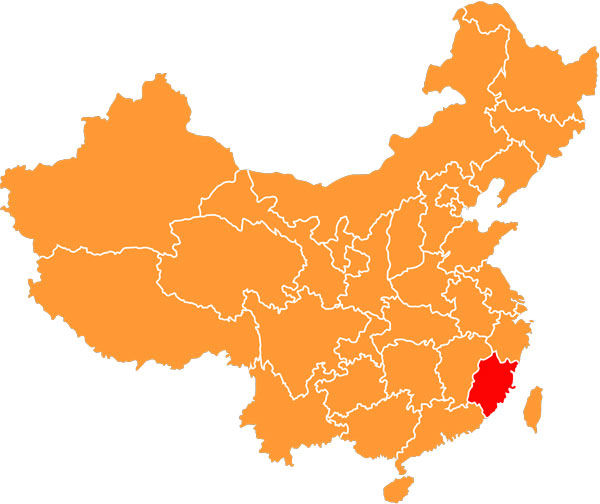
Fujian (Chinese: 福建省 Fújiàn Shěng, formerly spelled Fukien by the Universal Postal Union) is a province in the southeastern part of the People's Republic of China. The name of the province was composed during the Tang Dynasty from the names of two cities, Fuzhou and Jian'ou.
The coastline of Fujian measures approximately 530 kilometers in a straight line. However, due to numerous bays and peninsulas, the coastline extends to about 3,080 kilometers.
The terrain is mountainous and forested. The Wuyi Mountains, with an elevation of 2,100 meters above sea level at its border with Jiangxi, are the highest peaks in the province. The longest river, the Min River, which drains two-thirds of Fujian's area, gave the province its abbreviated name, Min.
The climate of the province is subtropical. The average annual temperature ranges from 17 to 21 °C, and the average annual rainfall ranges from 1,100 to 2,000 mm, with the majority (80-85%) falling between May and September.
Due to its history and mountainous landscapes, Fujian is one of the most linguistically diverse places in the world. Dialects vary from valley to valley, all belonging to the Min language group, which includes Taiwanese. However, Mandarin Chinese is the official language and is used for communication among people from different regions.
Along the western provincial border rises the Wuyi Mountains, renowned for their pristine mountain and river landscapes and designated as a UNESCO World Heritage Site for both cultural and natural significance.
Towards the region bordering Guangdong, there are significant clusters of Hakka tulou circular dwellings.
Fuzhou, or Futschou, is the capital of the Chinese province of Fujian. Fuzhou is an important port city on China's southeast coast. It has access to the Pacific Ocean via the Taiwan Strait. The city is also known as the Banyan City due to the many banyan fig trees planted there nearly 900 years ago, with impressive specimens found throughout the downtown area.
Nearly 90 rivers and more than 50 hills are scattered across Fuzhou's districts, creating optimal natural conditions for building a city with very good living conditions.





FUZHOU CHANGLE INTERNATIONAL AIRPORT
Located about 50 kilometers from the provincial capital, Fuzhou, it is the main airport of the provincial capital. All major Chinese metropolises are served here. There are ambitious plans to upgrade the airport successively by 2030. A metro is planned, but currently, the airport can be reached by bus or taxi.
XIAMEN GAOQI INTERNATIONAL AIRPORT
The large airport has been gradually expanded and is now known as one of the busiest in China. However, it will be replaced in 2025 by the new Xiamen Xiang’an International Airport (as of 2024).
XIAMEN XIANG'AN INTERNATIONAL AIRPORT
The new international airport, located 25 kilometers from the city center of Xiamen, is an airport under construction, with the planned opening in 2025 (as of 2024). It is expected to handle 85 million passengers by 2040 and will also be connected to the Xiamen metro. Additionally, the new construction is inspired by the local architecture of the Minnan region.